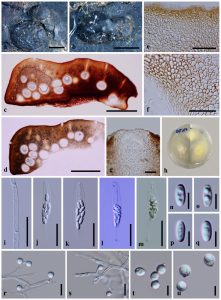Catabotrys deciduum (Berk. & Broome) Seaver & Waterston, Mycologia 38: 184 (1946)
Index Fungorum number: IF626984
Saprobic on petioles and rachides of palms. Sexual morph: Stromata solitary or irregularly scattered, conspicuous, multi-loculate, superficial, with base slightly penetrating the epidermis at regular intervals, discoid to pulvinate, reddish brown to black, surface scurfy, flat or slightly convex. Ascomata deeply imbedded in stromatic columns, globose, with a long, periphysate, ostiolar neck. Peridium composed of several reddish-brown outer layer cells of textura globosa and textura epidermoidea, with pale brown to hyaline internal cells of textura angularis. Paraphyses 5–6.5 µm wide, hypha-like, numerous, tapering towards the apex, not embedded in a gelatinous matrix. Asci 56.5–66 × 7.3–9.5 μm (x̅ = 60.4 × 8.8 μm, n = 20), 8-spored, unitunicate, broad cylindrical, short pedicellate, apically rounded or truncate, with a J-, discoid, refractive, apical ring. Ascospores 7.5–9.7 × 3–4.5 μm (x̅ = 8.6 × 3.8 μm, n = 30), bi-seriate, hyaline, 1-celled, ellipsoidal to cylindrical, smooth-walled. Asexual morph: Hyphomycetous. Vegetative hyphae hyaline, septate, smooth-walled. Conidiophores micronematous. Conidiogenous cells holoblastic, terminal and intercalary. Conidia 3.5–7 × 3–7 μm (x̅ = 5.3 × 4.7 μm, n = 80), globose or obovoid, hyaline, 1-celled and smooth-walled, often with denticles from conidiogenous cells.
Material examined – Thailand, Chumphon, Amphoe Pathio, on rachis of Salacca sp. (Arecaceae), 1 December, 2016, S.N. Zhang SNT33B (MFLU 18-1072); Thailand, Ranong, Amphoe Mueang Ranong, on decaying petiole of Elaeis guineensis (Arecaceae), 29 August 2017, S.N. Zhang SNT214 (MFLU 18-1073, HKAS 97484), living culture MFLUCC 18-0463.
GenBank numbers – LSU: MK078621 (MFLUCC 18-0463), MK078623 (MFLU 18-1072); ITS: MK078619 (MFLUCC 18-0463); SSU: MK078624 (MFLUCC 18-0463), MK078626 (MFLU 18-1072), MK078625 (MFLU 18-1073); TEF1-α: MK087661 (MFLUCC 18-0463), MK087663 (MFLU 18-1072), MK087662 (MFLU 18-1073); RPB2: MK087671 (MFLUCC 18-0463).
Known distribution (based on molecular data) – India (Hyde et al. 2020c), Panama (Huhndorf et al. 2004), Thailand (This study).
Known hosts (based on molecular data) – Salacca sp., Elaeis guineensis (This study), Rhizophora mucronata (Hyde et al. 2020c).
Notes – Catabotrys deciduum has been recorded from many localities and mostly found from palms (Theissen & Sydow 1915, Seaver & Waterston 1946). Huhndorf et al. (2004) provided the first sequence data for C. deciduum, which was obtained from a Panama specimen that preserved in the Field Museum of Natural History, Chicago, Illinois. Herein, we provide two fresh collections of C. deciduum from two kinds of palms in Thailand with morphological and molecular data.

Fig 1. Catabotrys deciduum (MFLU 18-1073). a, b Appearance of stromata on host surface. c, d Vertical sections through the stromata. e, f Structure of peridium. g Ostiole with periphyses. h Colonies on PDA. i Paraphyses. j–m Asci. l Ascus in Cotton blue. m Ascus apex in Mealzer’s reagent, J- subapical ring. n–q Ascospores. r–u Sporulation in culture. t, u Conidia in culture. Sacle bars: a, b = 2 mm, c, d = 1000 μm, e, f = 50 μm, g–m = 20 μm, r, s = 10 μm, r, n–q, t, u = 5 μm.
